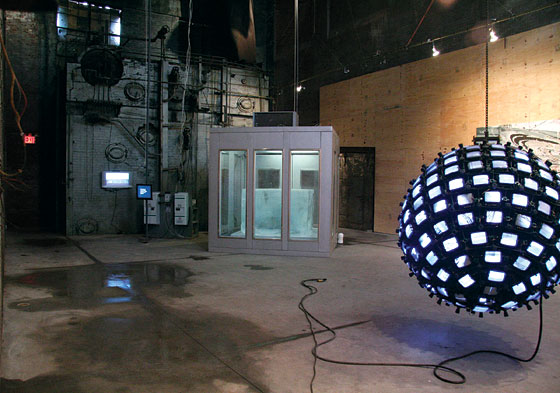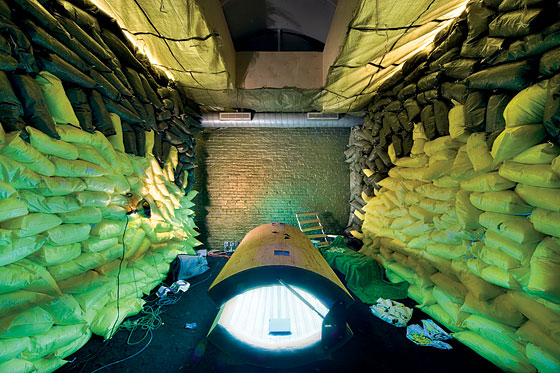
The New York art world readily proves people wrong. Just when folks say that things stink and flibbertigibbet critics wish the worst on us all because we’re not pure enough, good omens appear. The same weekend I saw so many dealers braving the odds at art fairs, I attended the debut of not one but two new art spaces. The energy in both venues was about feeling for the outlines of a changing configuration, looking for paths between the difficult and the iffy, and using the extraordinary human and architectural infrastructure already here.
Around midnight at Boiler, the new exhibition site he was unveiling in Williamsburg, I asked artist/gallerist/local hero Joe Amrhein why he was opening this giant old building in the midst of a recession. Amrhein, who has operated the nearby Pierogi gallery on a shoestring since 1994, replied, “I couldn’t afford not to do it.” Presumably he was referring to the chance to show art in this amazing setting—a combination of Gordon Matta-Clark cut-up pier, eighties sex club, and the engine room of the Titanic. Amrhein ripped out all but one of the boilers and poured new floors, clearing a decade’s worth of pigeon droppings. With its gritty bricks, 40-foot ceiling, and looming namesake, Boiler is a sight for eyes sore from seeing too many white cubes.
The gallery’s three-person debut isn’t stellar, but it is up to the space. You can see Pierogi’s penchant for verisimilitude in Yoon Lee’s twenty-foot-long painting of what looks like an expanding plasma field by way of Matthew Ritchie, Julie Mehretu, and Roy Lichtenstein. It needs a more original idea of unfinishedness to escape its brainy, super-graphic gravity. Jonathan Schipper’s giant sphere of video monitors and cameras looks like a wrecking ball and is an example of the Rube Goldberg–like constructions that Pierogi favors. But once you grasp that the cameras show the other side of the sphere, there’s not a lot more to think about.
The standout here is Tavares Strachan. In 2004, Strachan cut a 2.5-ton block of ice from the Alaskan Arctic, shipped it to the Bahamas (where he’s from), and exhibited it there in a hermetically sealed refrigerated room powered by solar cells. Pictures suggest that it was interesting there; now, installed in a former boiler room, it’s like hell freezing over. Far above the case two fans blow two flags: one at the current wind speed of Mount McKinley, the other at the Bahamas’ Nassau airport’s. The piece looks like a weird cryogenic chamber and touches on environmentalism, earthworks, entropy, autobiography, and race (making an oblique reference to Matthew Henson, a black explorer who was with Robert Peary at the North Pole).
One key to New York’s near future may have to do with whether local audiences can break their decades-old aversion to crossing water for visual culture. Amrhein makes a case that this is possible and necessary. He suggests a tantalizing alternative reality, one in which the megalomaniac former Guggenheim director Thomas Krens had not wasted bales of money on global boondoggles but instead followed the example of the Tate, converting a gigantic factory in Long Island City—or, as some have proposed, the former Domino Sugar factory in Williamsburg—into a Guggenheim Contemporary. Had that happened, the Manhattan-centric boom years might have nurtured an outer-borough art world more resilient to downturns. But such a top-down investment wasn’t made when it could have been, so now it will have to be cultivated from the bottom up.
Similar waves of possibility and regret washed over me when I visited X Initiative, the dynamite not-for-profit temporarily installed on West 22nd Street. The building it occupies was the site of the most egregious institutional blunder committed in my lifetime. In May 2003, Michael Govan, the former director of the Dia Center for the Arts (and a Krens protégé), opened an enormous facility in Beacon, New York, to exhibit Dia’s permanent collection. The upstate space is superb, but its opening was quickly followed by the closing of Dia’s magnificent gallery in the city. When, at the opening evening of X Initiative, I ran into current Dia director Philippe Vergne, all he could say was, “Grrrrrrr.” He knew what everyone else was feeling: This should still be Dia’s home.

No one seems to know what will happen to the space next spring, but thanks to gallerist Elizabeth Dee and project overseers Cecilia Alemani and Jenny Moore, for the next twelve months you can check your Govan-hate at the door and visit X Initiative for free. The organizers had only two months to assemble the project, so kudos are due despite the fact that the first round of shows is a bit dry (and too close to Dee’s exhibition program: She has shown two of the three artists). Three floors of exhibition space are given over to early Super 8 films by director Derek Jarman. It’s great to immerse oneself in Jarman’s sexy sensibility; you’ll see exotic dancers and naked boys with cute seventies bushy hair. But given how many other things could be going on here, three floors of Jarman is two too many. On the ground floor, Mika Tajima’s prints on wheels and mirrored pallets are a fair combination of order and confusion, but the whole thing is too hygienic and knowing. On the roof, there’s a generic but nevertheless crazy installation by Christian Holstad that features a colonic machine, a working tanning booth, and what look like gold-plated feces, all of which supposedly have to do with gay leather sex clubs and health spas. Actually, it might fit better at Boiler.
All over the city, the same hard times that are forcing some galleries to close seem to be creating opportunities for other spaces to pop up or reopen; an incomplete list includes not only Boiler and X Initiative but also Small A Projects, Lisa Cooley, Rachel Uffner Gallery, Light Industry, APF Lab, Scaramouche, Cleopatra’s, Dispatch, Triple Candie, Privateer, new digs for Participant Inc., Sue Scott Gallery, Pocket Utopia, On Stellar Rays, and Invisible-Exports. Who knows how many of these will be around in 48 months or even a year? What matters is that they’re here now, exactly when we need them, already creating energy and starting to make a difference. I love this town.
Boiler
191 N. 14th St. Williamsburg.
Through April 19.
X Initiative: Phase I
548 W. 22nd St. Chelsea.
Through May 30.
E-mail: jerry_saltz@newyorkmag.com.